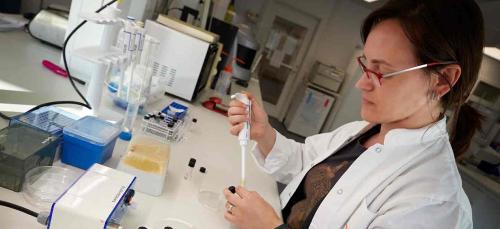Can nanomaterials be used as shields against bacteria and viruses?

With a research grant of DKK 2 million from the Villum Experiment Programme, Associate Professor Biljana Mojsoska will investigate the potential ability of nanostructures to recognise specific molecules in, for example, environmental toxins, bacteria and viruses.
“If we succeed in this project, one of the potential applications is to create bacteria-repellent surfaces for medical devices that are in direct contact with the body, such as catheters and contact lenses,” says Biljana Mojsoska.
The basic idea is inspired by the way nature itself can form folded proteins from amino acids. In the project, Biljana Mojsoska’s research group will investigate the potential for artificially designing so-called peptoid polymers, which can be assembled like chemical building blocks into new nanomaterials with highly specific properties.
“In the laboratory, I basically build molecules that can be assembled into new nanostructures. In many products, surface chemistry and function are closely linked, and we hope to develop nanomaterials that can eventually be produced industrially in a cheaper, faster and more sustainable way than is the case today,” says Biljana Mojsoska.
High-risk funding to test original research ideas
The research project will run for the next two years with support from the Villum Experiment Programme. The programme provides high-risk funding for research projects to try out unconventional research ideas that have the potential to fundamentally change our knowledge of the world.
This year, the Villum Experiment Programme has allocated a total of DKK 99 million to 51 scientists, for research projects which have had to pass through a very special needle’s eye: All of the applicants have been anonymised before an international review panel, to sharpen the focus of the research ideas and allow scientists to think freely.
兴发娱乐官网手机版客户端 University’s research into new nanomaterials is carried out in close collaboration with scientists from the University of Copenhagen and the Lawrence Berkeley National Laboratory in Berkeley, California.
More information:
For further information, please contact:
Associate Professor Biljana Mojsoska, e-mail, biljana@ruc.dk
Read more about the grant and the Villum Experiment Programme on the foundation’s website.
Basic research in new nanomaterials
Biljana Mojsoska’s research seeks to answer one of the fundamental questions in nanotechnology: Can nanosurfaces with specific properties be produced in a fast, simple and environmentally safe manner that will work in the same way, regardless of the material coated with the nanomaterial?
The Villum Experiment grant makes it possible to explore the basic scientific elements of these nanostructures, and to subsequently test the stability of the nanostructures developed and thereby their potential to find application in various biological contexts.
The aim is to develop a concept by which nanosurface materials can be produced using synthetic polymers that resemble the structure of peptides. By creating specific sequences of these molecules, the polymer can be shaped into the desired structures – such as sequences that recognise bacteria and create a nanosurface that affects the bacteria and kills them.